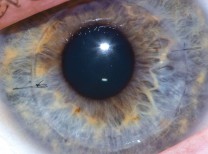Have you ever been told by your eye doctor that you have keratoconous [ker-uh-toh-koh-nuhs], a type of astigmatism that cannot be fully corrected with glasses or soft contact lenses? To understand keratoconus, you must first understand that the eye has many components that all work together to help you see including the cornea, lens, and retina.
The effect of the lens on vision is well-known due to the prevalence of cataract surgery, which removes the natural lens once it becomes cloudy. What many people do not realize is that changes in the structure or function of the cornea also can dramatically affect vision. The cornea is the clear, dome-shaped tissue at the front of the eye that is largely responsible for how light is transmitted into the eye. Most people have a regular-shaped cornea (think a smooth dome) which allows for undistorted light transmission. This is not true for people with keratoconus.
Keratoconus belongs in a group of diseases called corneal ectasias which causes corneal thinning and forward bulging of these thin areas. This thinning and consequent bulging creates irregular astigmatism, which distorts transmitted light rays and often cannot be fully corrected by glasses or soft contact lenses.1 Additionally, a thinning cornea is unstable and can lead to permanent scarring. Excessive scarring may necessitate a corneal transplant. Other surgical treatments include an intrastromal corneal implant and corneal cross linking.2
Keratoconus tends to be progressive in individuals in their 20s and 30s and stabilizes after the 40s. Signs and symptoms include distorted vision, sensitivity to light and glare, complaints of shadow or ghost images, frequent prescription changes, and decreased visual acuity. Studies have shown that eye rubbing plays a role in the progression of keratoconus. Therefore, treatment for eye allergies is always addressed when keratoconus is suspected.3 It is also linked to systemic atopic diseases, such as eczema, allergic rhinitis, asthma, and food allergies.4 There may also be a genetic component to the development of the condition.5 Moreover, corneal ectasia may be associated with refractive surgery, such as LASIK. People with post-LASIK corneal ectasia have similar visual symptoms to those with keratoconus.6
In the past, the only non-surgical treatment for keratoconus was rigid gas permeable lenses (RGPs). Its rigid shape masks the irregular cornea and creates a smooth refractive surface similar to the healthy eye. However, RGPs could cause discomfort and irritation.
Recently, major advances in specialty contact lenses have allowed many people with keratoconus to avoid a corneal transplant and enjoy better vision. New specialty contact lenses including scleral lenses, hybrid lenses, custom soft lenses, and piggyback lenses have evolved to improve vision as well as provide comfort for people with the condition. People with post-LASIK ectasia also do very well with specialty contact lens.
At your next annual eye exam, tell your eye doctor if you have experienced any of the symptoms mentioned above to be screened for early signs of keratoconus or other corneal ectasias.
Dr. Thanh-Vi Nguyen is a co-founder of Desert Eye Associates in La Quinta and Palm Desert. She has special interest in fitting specialty contact lenses for eye diseases and can be reached at (760) 342.6900 or email at [email protected].
References: 1) Basic and Clinical Science Course. Lens and Cataract. American Academy of Ophthalmology. 2012-2013 2) Asimellis G, Kaufman EJ. Keratoconus. [Updated 2017 Dec 17]. In: StatPearls [Internet]. Treasure Island (FL): StatPearls Publishing; 2018 Jan 3) Yeniad B, Alparslan N, Akarcay K. Eye rubbing as an apparent cause of recurrent keratoconus. Cornea. 2009 May;28(4):477-9 4) Thyssen, JP, Toft, PB, Halling-Overgaard, AS, Gislason, GH, Skov, L, Egeberg, A. Incidence, prevalence, and risk of selected ocular disease in adults with atopic dermatitis. J Am Acad Dermatol 5) Mas Tur V, MacGregor C, Jayaswal R, O’Brart D, Maycock N. A review of keratoconus: Diagnosis, pathophysiology, and genetics. Surv Ophthalmol. 2017 Nov 6) Binder P.S. Ectasia after laser in situ keratomileusis. J Cataract Refract Surg. 2003;29(12):2419–242















































Comments (0)